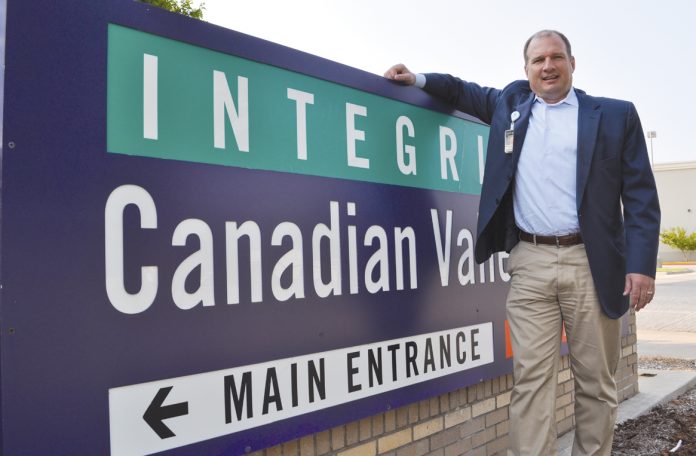
story and photo by Bobby Anderson, Staff Writer
Valerie Austin, MBA, BSN, RN, CEN currently is the administrative director at Integris Canadian Valley Hospital.
But not too long ago she was a flight nurse in Arizona, flying wherever she was needed at a moment’s notice.
Austin understands all too well what it means to put on a flight suit and step into an air ambulance. Less than a year after she left the field in Arizona her chopper crashed.
“It killed the nurse that replaced me and the paramedic and one of my favorite pilots,” Austin said. “It was a mechanical issue. That’s why safety is always in the forefront.”
And while it was expected that landing at an accident site could be nerve-wracking it was always a comfort knowing the return trip landing would be at a place conducive for a quick transfer into the facility.
It’s one of the reasons she’s so passionate about an ongoing project to bring Integris Canadian Valley its first helipad.
“It’s for the safety of the flight crews and the patients coming in,” Austin said. “When I flew … you’re really on edge. It’s a dangerous industry just by nature when you’re up in the air. When you’re landing on an unimproved landing site versus an improved one there’s just that much more anxiety that goes along with it.”
WHERE THE SIDEWALK ENDS
Over the past year the number of transfers – by air and by land – to ICVH has grown several fold.
And when a helicopter touches down it’s on a grassy patch near the ER.
There’s a paved sidewalk that reaches halfway.
“It’s huge,” Austin said. “The pilot is always focused on safety and getting you there safely. But when you’re in the flight crew it gives you a breather. You know you’re landing somewhere nice. You know you’re good so you can focus on patient care.”
In order to build a landing pad the hospital needs to raise funds. A major step in that direction will be this Friday’s Big Hats Big Hearts event at 10 W Main in Yukon.
“We’re trying to have a great relaxed evening of fellowship with music, food and casino games to raise money,” Integris Canadian Valley Hospital President Rex Van Meter, MHA said. “A hospital helipad is pretty expensive.”
Van Meter said current bids for the pad are $240,000 and up.
The 16-year-old hospital has experienced phenomenal growth with two major capital projects including a third floor.
“We’re seeing volumes grow and we’re seeing patients from other communities being sent here for care,” Van Meter said.
The Integris Transfer Center fields calls from hospitals around the state for placement within the Integris network.
During the calendar year of 2014, ICVH received just 30 transfers from the center. This calendar year is already shaping up for more than 200.
Most are by ground but air transfers are rising.
“We’re becoming a destination,” Van Meter said. “With the struggles with some rural hospitals and funding issues … and at times hospitals are on divert status that’s been fueling the volume coming here the last several years.”
Each time the hospital accepts an air ambulance the Yukon Fire Department is called out to set up a perimeter. That takes a rescue crew out of service.
The hospital’s east parking lot has become an inclement weather landing site if the grass landing zone becomes saturated.
“When you’ve got a 200-pound patient on a stretcher you can’t pull that across the grass to get the patient indoors,” Austin said. “(The mud) will go up to your mid calves. Whatever we can get will be very nice.”
Van Meter calls it a community project with a benefit that will ripple statewide.
“It’s part of the growth of the hospital,” Van Meter said. “We probably should have had a helipad for a while but we feel like it’s a project we can rally the community around and they can see the impact that help benefit those patients most at-need.”
Austin’s flying days are behind her, but the memories of what could have happened will stay with her forever.
She just wants flight nurses, paramedics, pilots and ultimately patients to have the best chance at success possible.
“The pilot is the one that makes that call whether they can fly or not,” Austin said. “I knew when I woke up at 2 a.m. the first thing that he would look at is the radar to see if we could take this flight or not. With windy conditions in Oklahoma, unimproved pads there are things that can blow on them or in the way. We just want to keep our people safe.”
And that means giving them a safe place to land.













